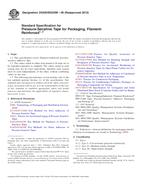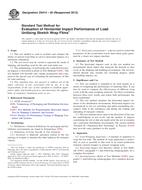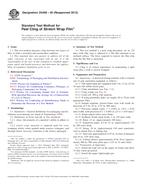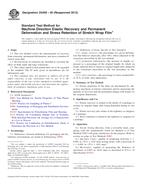We need your consent to use the individual data so that you can see information about your interests, among other things. Click "OK" to give your consent.
ASTM D4728-06(2012)
Standard Test Method for Random Vibration Testing of Shipping Containers
STANDARD published on 1.4.2012
The information about the standard:
Designation standards: ASTM D4728-06(2012)
Note: WITHDRAWN
Publication date standards: 1.4.2012
SKU: NS-28328
The number of pages: 7
Approximate weight : 21 g (0.05 lbs)
Country: American technical standard
Category: Technical standards ASTM
The category - similar standards:
Annotation of standard text ASTM D4728-06(2012) :
Keywords:
distribution environment, random vibration, shipping container, vibration, vibration control, Closed loop technique, Instrumental measurement, Open loop technique, Performance--containers/packaging/shipping, Random vibration test, Resonances, Shipping containers/materials/applications, Stress, Vibration test--packaging/shipping materials, ICS Number Code 55.020 (Packaging and distribution of goods in general)
Additional information
| Significance and Use | ||||||||
|
Shipping containers are exposed to complex dynamic stresses in the distribution environment. Approximating the actual damage, or lack of damage, experienced in real life may require subjecting the container and its contents to random vibration tests. In this way, many product and container resonances are simultaneously excited. Resonance buildups during random vibration tests are less intense than during sinusoidal resonance dwell or sweep tests. Therefore, unrealistic fatigue damage due to resonance buildup is minimized. Random vibration tests should be based on representative field data. When possible, confidence levels may be improved by comparing laboratory test results with actual field shipment effects. Refer to Practice D4169 for recommended random vibration tests. (See Appendix X1 and Appendix X2 for related information.) There is no direct equivalence between random vibration tests and sinusoidal vibration tests. Equivalent tests between sine and random, in a general sense, are difficult to establish due to nonlinearities, damping and product response characteristics. Vibration exposure affects the shipping container, its interior packing, means of closure, and contents. This test allows analysis of the interaction between these components. Design modification to one or all of these components may be used to achieve optimum performance in the shipping environment. Random vibration tests may be simultaneously performed with transient or periodic data to simulate known stresses of this type, that is, rail joints, pot holes, etc. Random vibration may be conducted in any axis (vertical or horizontal) or in any package orientation. However, different test levels may be utilized for each axis depending on the field environment that is to be simulated. |
||||||||
| 1. Scope | ||||||||
|
1.1 This test method covers the random vibration testing of filled shipping units. Such tests may be used to assess the performance of a container with its interior packing and means of closure in terms of its ruggedness and the protection that it provides the contents when subjected to random vibration inputs. 1.2 This test method provides guidance in the development and use of vibration data in the testing of shipping containers. Note 1—Sources of supplementary information are listed in the Reference section (1–10). 1.3 This standard does not purport to address all of the safety concerns, if any, associated with its use. It is the responsibility of the user of this standard to establish appropriate safety and health practices and determine the applicability of regulatory limitations prior to use. Specific safety hazard statements are given in Section 6. |
||||||||
| 2. Referenced Documents | ||||||||
|
Similar standards:
Historical
1.4.2012
Historical
1.4.2012
Historical
1.4.2012
Historical
1.4.2012
Historical
1.4.2012
Historical
1.4.2012
We recommend:
Technical standards updating
Do you want to make sure you use only the valid technical standards?
We can offer you a solution which will provide you a monthly overview concerning the updating of standards which you use.
Would you like to know more? Look at this page.



 ASTM D5330/D5330M-06..
ASTM D5330/D5330M-06.. ASTM D5414-95(2012)..
ASTM D5414-95(2012).. ASTM D5415-95(2012)..
ASTM D5415-95(2012).. ASTM D5416-95(2012)..
ASTM D5416-95(2012).. ASTM D5458-95(2012)..
ASTM D5458-95(2012).. ASTM D5459-95(2012)..
ASTM D5459-95(2012)..
 Cookies
Cookies
